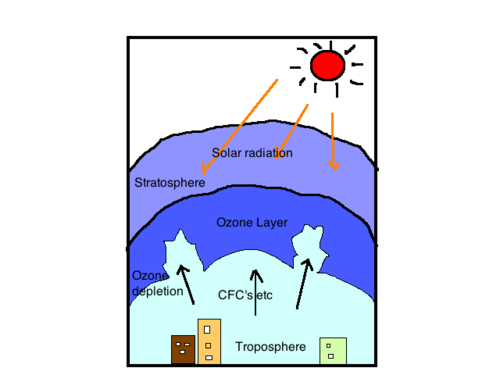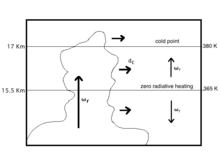Very short-lived substances
Very short-lived substances (VSLS) are ozone-depleting halogen-containing substances found in the stratosphere. These substances have very short lifetimes, typically less than 6 months. VSLS are responsible for atmospheric damage once they enter the stratosphere and are a contributing factor to the destruction of ozone.

Description
VSLS are ozone-depleting halogen-containing substances found in the stratosphere. These substances have very short lifetimes, typically less than 6 months.[1] Approximately 90% of VSLS are produced by natural processes and their rate of production is increasing. “They are bromine compounds produced by seaweed and the ocean's phytoplankton”.[2][3] Only 10% of ozone deleting chlorine compounds are man-made. VSLS are responsible for atmospheric damage once they enter the stratosphere and are a contributing factor to the destruction of the ozone layer. In previous decades it was believed that the most significant factor in ozone depletion was the increase in chlorofluorocarbons (CFCs). Currently VSLS are increasing rapidly, mainly due to industrial activities. The primary VSLS is n-propyl bromide (C3H7Br). It has been forecast that brominated VSLS will increase to about 8 - 10 % of the total VSLS emission by the end of 21st century. There has not been much research in this area, although this is changing as more scientists study this substance to predict its long-term impact on ozone levels.

Transport
The most significant route of air entering the stratosphere is through the tropical tropopause layer (TTL) via convection.[4] The air masses are shifted by convection are able to rise several kilometers within a few hours. This transport mechanism is fast enough for VSLS lifetimes.[5]
Effects
Despite their short lifespan, VSLS have been shown to contribute significantly towards the depletion of the ozone layer, particularly in the lower stratosphere above mid-latitude areas. [6] One study has shown that every five additional parts per trillion by volume (pptv) of VSLS in the atmosphere reducesthe global ozone column by about 1.3%.[7] Long-term calculations of VSLS injection into the stratosphere reveal a robust correlation between sea surface temperature, convective activity and the number of short-lived source gases in the tropical tropopause layer (TTL), which becomes especially clear during the perturbations induced by El Niño seasons.[7] This trend is attributed to increased activity by bromine-generating marine life under warmer temperatures and indicates that VSLS concentration will likely increase over the 21st century due to climate change.[8] The potential significant increases in the atmospheric abundance of short-lived halogen substances, through changing natural processes or continued anthropogenic emissions could be important for future climate.[9]
References
- "very short-lived substances". www.rappler.com. Retrieved 2018-02-20.
- Puiu, T. (2015, February 18)
- ZME Science. Retrieved 25 May 2017, from http://www.zmescience.com/ecology/climate/short-lived-chemicals-ozone-layer-053234/
- (n.d.). Very Short-lived substances. Iup.uni-bremen.de. Retrieved 25 May 2017, from http://www.iup.uni-bremen.de/atmospheric/research/veryshortlivedsubstances/index.html
- Ingham, R. (2015, February 17). Scientists alarmed at short-term ozone-eroding gases. Rappler. Retrieved 25 May 2017, from http://www.rappler.com/trending/%20very%20short-lived%20substances
- "Some of the ozone layer is still thinning, thanks to a surprise chemical". Futurism. 2018-02-19. Retrieved 2018-02-20.
- Aschmann, Jan (14 October 2011). "Impact of VSLS on Stratospheric Bromine Loadingt" (dissertation): 1. Cite journal requires
|journal=(help) - "Biogenic Bromine Species: Earth and Environment". www.see.leeds.ac.uk. Retrieved 2018-02-20.
- Hossaini, R., Chipperfield, M., Montzka, S., Rap, A., Dhomse, S., & Feng, W. (2015, February 16). The efficiency of short-lived halogens at influencing climate through depletion of stratospheric ozone. Retrieved 25 May 2017, from http://www.nature.com/ngeo/journal/v8/n3/full/ngeo2363.html?WT.ec_id=NGEO-201503